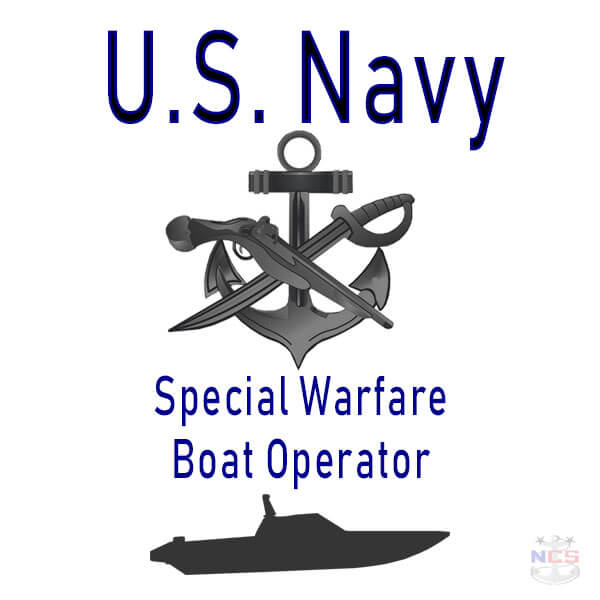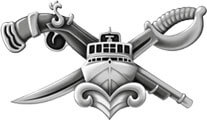The SB Rating

The Special Warfare Boat Operator (SB) rating was established on October 1, 2006.
The Naval Special Warfare Combatant-Craft Crewman (SWCC) program evolved from the PT boats Sailors of WWII and the "Brown Water Navy" of Vietnam. They are specially trained to conduct and support Special Operations missions in a maritime environment and work primarily with Naval Special Warfare Sea, Air, and Land Teams (SEAL).
The Navy's computerized personnel system associates the rating name with an alphanumeric Navy Navy Enlisted Manning Code (EMC). For SB, the EMC is E350.
The Special Warfare Boat Operator rating requires a 72 month (six year) enlistment obligation.
Special Warfare Boat Operator class "A" school is broken into six phases and is in total approximately 62 weeks in duration. Phase One is eight weeks of Special Warfare Preparatory School located in Great Lakes, Ill. Phase two is three weeks of Special Warfare Combatant-craft crewman indoctrination; Phase Three is five weeks of Basic Crewmember Training; Phase Four is 21 weeks of Crewman Qualification training -- located in Coronado, California. Phase Five is 12 weeks of Initial Acquisition Training, and it is located in San Diego, California. The final phase is located in Stennis, Mississippi and is 13 weeks in duration -- it is advanced training in SWCC core skills.
Special Warfare Boat Operator job description
Special Warfare Boat Operators support and perform maritime Special Operations in open ocean, littoral, and riverine environments. They provide maritime insertion and extraction of Special Operations Forces (SOF) and others.
SBs possess unique skills in the operation, maintenance, and repair of specially configured combatant craft, and they operate small arms and crew-served weapons. They operate, maintain and repair tactical communications equipment, and use paradrop techniques to insert combatant craft.
Other skills include small boat tactics, tactical ground mobility, trauma care, intelligence gathering and interpretation, and chemical/biological/radiological/nuclear defense measures.
The Special Warfare Boat Operators also conduct direct action raids against enemy shipping and waterborne traffic.
Career Sea - Shore Rotation Chart
| Rating | SEA1 | SEA2 | SEA3 | SEA4 | SEA/SH |
|---|---|---|---|---|---|
| SB | 60 | 60 | 48 | 48 | 36/36 |
| SH1 | SH2 | SH3 | SH4 | ||
| 36 | 36 | 36 | 36 |
The Naval Special Warfare community is a sea-intensive community. Due to the unique nature of the special warfare mission, Sailors in the elite rating of Naval Special Warfare Boat Operator (SB) should expect to serve back-to-back sea tours prior to assignment ashore. Sailors in this rating can expect their initial back-to-back sea tours to be within the same geographic location, contingent upon the needs of the Navy and NSW.
Qualifications, Interests, and Working Environment

Qualifying for SWCC (SB Rating) in Delayed Entry Program is preferred and accounts for the majority of SWCC applicants in the training pipeline. Candidates may also volunteer for SWCC during basic training at Recruit Training Center (RTC), or at any time during their enlistment prior to their 31st birthday.
NSW/NSO "Dive" Motivators, at RTC, give presentations on the Navy's NSW/NSO programs, conduct the physical training screening tests, and assist interested Recruits with their applications at RTC. A more stringent physical examination and medical screening is conducted at RTC. Recruit's entrance medical examinations will be reviewed and further physical screening tests will be given at RTC and at the Naval Special Warfare Center (SWCC School).
SWCC training is physically and mentally demanding. SWCCs receive extra pay for special duty assignment. Some SWCCs are selected for parachute training in both Static Line and Military Free Fall. SWCC candidates should be motivated, self-assured and self-confident, willing to follow orders and able to work under stressful and hazardous conditions. They should be in excellent physical conditions and motivated to withstand the rigorous physiological demands imposed by the maritime environment.
The ability to swim and withstand fatigue is a major factor in successful completion of the Basic SWCC training. Other necessary characteristics needed are good aptitude for mechanical skills, study habits, knowledge of arithmetic and basic algebra, and manual dexterity.
SWCC candidates must be U.S. citizens eligible for security clearance. Adversely adjudicated drug abuse offenses will not receive waiver consideration with the potential exception of a single misdemeanor charge involving marijuana (only on a case-by-case basis).
Uncorrected visual acuity worse than 20/40 in the better eye is disqualifying for SWCC. Uncorrected visual acuity worse than 20/70 in either eye is disqualifying for SWCC. Corrected visual acuity worse than 20/25 in either eye is disqualifying. Must have normal color perception. No color deficiency waivers authorized. Visual acuity standards are not waiverable for SWCC candidates.
SWCC ASVAB Test score requirements.
SWCCs perform Special Operations missions from high speed small boats, fixed wing aircraft, helicopters, and Navy ships. They may be exposed to arctic, desert or jungle environments, including survival in enemy controlled areas. They may also perform administrative and foreign training missions in a wide variety of climates throughout the world.
About 900 Sailors work in the Navy's Special Warfare Boat Operator (SWCC) rating.
Personnel in the Special Warfare Boat Operator (SWCC) rating are paid allowances (BAH, BAS, etc. if eligible) and enlisted basic military pay based on years of service and paygrade.
Credit Recommendations
The American Council on Education recommends that semester hour credits be awarded in the vocational certificate and lower-division bachelor's/associates degree categories for courses taken in this rating.
Page written and maintained by NCCM Thomas Goering, USN (Retired).
If you are seeking information about joining the Navy, feel free to contact me.
